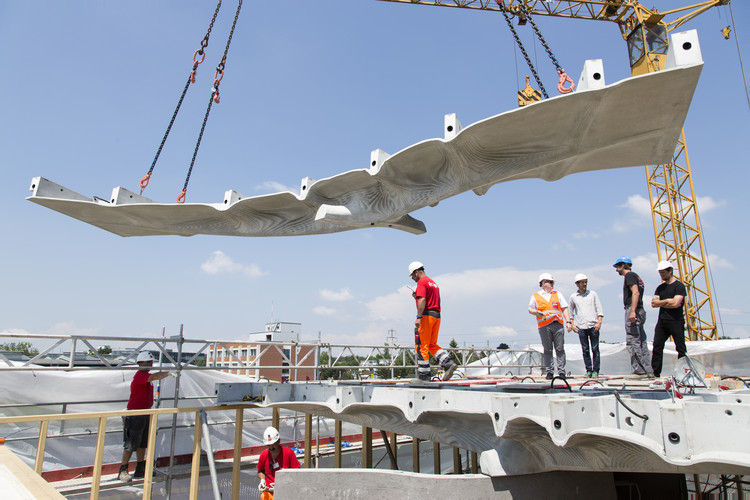
-
Architects: NCCR Digital Fabrication
- Year: 2019
-
Manufacturers: Ertex

Text description provided by the architects. DFAB HOUSE marks the first time that a full scale, the inhabited multi-story building has been designed and built using advanced digital fabrication methods. The project is the result of a nationwide interdisciplinary research initiative in Switzerland, called NCCR Digital Fabrication, aimed at transforming the design and building process by integrating computational design and digital fabrication into architecture. Its design concept is based on leveraging the full architectural potential of selected novel digital building processes in the field of robotic fabrication and 3 D printing technologies through integrated processes.

To realize DFAB HOUSE, researchers at seven ETH Zurich professorships came together with industry experts and planning professionals in a unique way to demonstrate and test how digital fabrication can change the way we design and build. The design of the DFAB HOUSE leverages six research innovations: the In situ Fabricator, a versatile autonomous on-site construction robot; Mesh Mould, a formwork-free, robotic process for steel-reinforced concrete structures; Smart Dynamic Casting, an automated concrete slip-forming process; Smart Slab, integrated ceiling slabs fabricated with 3D-printed formwork; Spatial Timber Assemblies, a robotically fabricated timber structure; and Lightweight Translucent Facade, a membrane skin filled with translucent thermal insulation.



The ground floor of DFAB HOUSE is designed to be a shared space. Characterised by floor to ceiling windows supported by 15 bespoke, curved concrete mullions, the centrepiece of the room is the Mesh Mould wall, an S-shaped structure providing natural shared and hidden spaces to the house’s inhabitants. The non-standard, curvilinear wall provides load-bearing support for the undulating Smart Slab, a geometrically complex structure, forming the ceiling.

Travelling up to the second and third floors of DFAB HOUSE, visitors are transported from the clean yet organic lines of the ground floor to the feel of a contemporary Alpine chalet on the residential second and third floors. Split into four standalone apartments, robot-built Spatial Timber Assemblies provide a warm, homely feel and catch the eye with their non-uniform placement, while the lightweight translucent facade made with Aerogel ensures that natural daylight penetrates the outward-facing walls, while also providing inhabitants with privacy and thermal comfort.


Using digital techniques to constantly update during the design process, each architectural element is made bespoke, allowing each part to be engineered exactly for its individual function. By creating innovative objects that are perfectly engineered for the space that they will occupy, DFAB HOUSE also represents an important step forward in sustainability in architecture. Through tailoring each element to its conditions, the material savings were significant.


In fact, the Smart Slab alone offers 65% weight reduction as compared to traditional slabs, and Mesh Mould is a formwork-free, zero-waste application that also uses an optimised, intelligent shape to minimise material use. The architecture of DFAB HOUSE leverages digital fabrication to make tailored designs economical while exposing all structural elements of the building in their true materiality, producing varied and tactile spaces rather than dull repetition. DFAB HOUSE opens the door to a new, digital building culture where new design opportunities merge seamlessly with resource efficiency.































